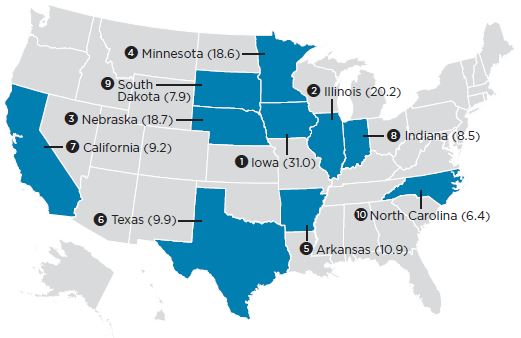Not all ethanol is created equal. The benefits, or consequences, of this ubiquitous ‘home-grown’ fuel that is blended in nearly every gallon of gasoline sold across the country vary depending on how it is produced and what it is produced from. As my colleague and uber biofuels-wonk Dr. Jeremy Martin has explained, ethanol produced from food, like corn or soybean, does little to reduce the carbon intensity of our transportation fuel and, in some cases, can actually be responsible for more greenhouse gas emissions on a lifecycle basis compared to gasoline.
How much biomass could be harvested?
However, ethanol can also be produced from non-food sources, like fast growing grasses or yard trimmings and other municipal waste. In 2012, UCS produced a report on how much of this non-food “biomass” could reasonably be harvested and turned into ethanol. We found that 680 million dry tons of cellulosic biomass could be made available, in a sustainable manner, each year within the U.S. by 2030. That is enough biomass to produce more than 10 billion gallons of ethanol, or 166 billion kilowatt-hours of electricity – 4 percent of total U.S. power consumption in 2010.
As a follow up to this report, we recently dove deeper into investigating the potential of agricultural residues and manure to produce sustainable, low carbon biofuels. We found that these resources are abundant across the country and included a map with the top 10 states with the potential for harvesting agricultural residues and manure.

About two-thirds of total projected U.S. crop residues and manure in 2030 will come from just 10 U.S. states. (Numbers in million metric tons)
What are agricultural residues?
Agricultural residues refer to the stalks, husks, cobs, and other bits that are left behind after each harvest. These materials have historically been used for animal bedding, burned, or left on fields, but recent scientific advances now allow producers to turn these leftovers into fuels such as ethanol, or to use them to generate electricity. Ethanol produced from sustainable sources like agricultural residues can produce as much as 80 percent fewer lifecycle emissions compared to gasoline.
Using these residues does not come without caution. Removing residues for fuel or electricity absent any other changes in agricultural practices could actually worsen existing environmental challenges, like nutrient runoff. Our fact sheet also details ways in which farmers can adapt their practices to minimize the potential harm of using these resources. For example, farmers can use no-till farming and plant cover crops to reduce soil erosion and water pollution. In so doing, they can boost agricultural productivity while expanding the amount of residues available for bioenergy even beyond our estimates. Also, by using anaerobic digesters to extract biogas from manure, small-scale livestock producers can improve water quality, reduce methane emissions, and return nutrients to their soils. The biogas can then provide heat and power for the farm, or it can be further purified and sold as renewable natural gas.
So, check out where agricultural residues and manure could be harvested and turned into fuel or electricity near you via this new fact sheet. And stay tuned to this blog and Dr. Martin’s blog for future updates on the world of biofuels and bioenergy.
